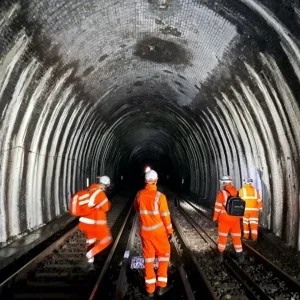Although not in boom conditions, the tunnelling industry in Western Europe still appears to be in a relatively healthy state with major projects under way in most countries. And yet companies are naturally nervous about the future.
London’s Crossrail recently announced, in conjunction with contract awards, that the project was now ‘unstoppable’, apparently with some considerable relief, even though the Government’s capital spending review had cleared the core of the project. It should be remembered that Crossrail was originally intended for completion for the London 2012 Olympics but, like many other major projects, had been delayed by early planning and financial concerns.
Throughout Europe it is natural to ask, “What happens when the current work has all been completed?”
Demands
The most common demands that should create tunnelling work are urban growth and congestion, aided by rapidly increasing fuel costs. Urban rail projects are a substantial activity, although not so much as in the rest of the world. These can place great demands on the tunnelling contractors and project managers, mainly to ensure that there are no settlement incidents and that logistics do not unduly affect normal city life.
Although cross-country high-speed rail projects with tunnels are still in action, such as in Germany, Spain and planned for France, the originally designated Trans European Network projects are nearing completion, with the exception of the new Lyon-Turin rail link. The emphasis has somewhat transferred to the infrastructure requirements of the new members of the EU in the East, and their neighbours, with major contractors following this work.
As for utilities, the major tunnelling market of sewerage is now reduced due partially to successful compliance with EU antipollution directives due to earlier projects, and better industrial practices including the ‘polluter pays’ principle. Exceptions in the UK include Southern Water’s Brighton scheme, which ironically had been delayed by environmental objections, and Thames Water’s Tideway main sewer project (including the Lee Tunnel).
Other utilities requirements include power cable tunnels (such as National Grid’s London project), whether to meet increased power demand, avoid storm damage or perhaps to link in with new sources such as wind farms), plus telecommunications.
Tunnelling is only a small part of the activities of some of the biggest names in Western Europe’s tunnelling industry, and much of that is off home soil. For example, Swedisg Skanska is active in general construction throughout Europe, but much of its large tunnelling work is now in the United States and Eastern Europe. An exception is shaft and headworks for a National Grid project in London.
Spain
Many other contractors are also looking further afield, perhaps for the first time. This is no truer than in the case of Spanish contractors and consultants that have seen the domestic tunnelling market, largely EU-funded, reduce rapidly. Thus these contractors have successfully bid for contracts in the UK, the US and other countries. It has been pointed out that this has a lot to do with good relationships with their bankers. The same will apply to other large and diversified contractors.
France
The biggest current tunnelling project in France, the Toulon highway tunnel to speed traffic around the city is approaching completion. Other major projects include the Lyon Metro (where the French tunnelling association and several other West European tunnelling associations are meeting this month) and the long-awaited Lyon-Turin rail link. There are also plans still on the books for high-speed (TGV) rail to unserved regions of France, around and even through Paris, plus metro (RATP and RER) extensions in greater Paris. Underwriting by the government is by no means certain however. Through mergers and acquisitions, France also boasts some of the largest tunnelling contractors in the world, with a wide international base such as Vinci, Bouygues and Dragages.
Italy
The Italian government has been annoyed by its recent credit-rating reduction, claiming that it earns enough to service its debt. Whatever the truth of this, the nation stills has substantial transport tunnelling underway including use of the world’s largest diameter TBM built to date (by Herrenknecht) for the Sparvo Tunnel for a highway in central Italy. Italy also exports its skills to a great extent, notably by Impregilo, Seli and Rocksoil.
Germany
As the leading economy in Western Europe, the tunnelling market in Germany should give a good indication of typical activity. However, its make-up has substantial differences from other countries mainly because long-distance travel by high-speed rail and road is still the dominant driver for demand.
The German tunnelling association and research organisation Stuva publishes detailed annual statistics of current and planned tunnel construction. The latest report by Alfred Haack and Martin Schaefer of Stuva shows a buoyant market. Transport tunnel construction increased from approximately 138km in 2008-09 to 159km in 2009-10 with a forecast of planned tunnelling for 2010-11 of 381km.
Most of this is for Deutsche Bahn’s (DB’s) long-distance railways, creating faster routes through ranges of mountains and hills, totalling 91km in 2009-10.
DB finances are backed up by a vibrant multi-national transport business and not just national requirements.
Eire
Famously affected by the current European economic situation and a collapse in the property market, Ireland has little tunnelling left as the Dublin Metro North and DART Underground projects have been cancelled and the Metro West postponed following planning delays and a financial review.
The Limerick Tunnel also demonstrates the dangers of private finance initiative projects when things don’t go right. The tunnel, as a business, has had its credit-rating downgraded since revenues are not as high as expected. This demonstrates the delicate balance that has to be struck between toll charges and the increasing cost of vehicle fuel.
Belgium
The Liefkenshoek rail tunnel recently broken through, is an example of how innovative financing is producing a badly needed asset that will result in wider economic benefits. This is perhaps a principle that could be followed by all projects facing difficult conditions. In this case the new rail link will allow faster transfer of goods to and from the Port of Antwerp, increasing both activity and revenues.
Netherlands
The Nord-Zuid rail route in Amsterdam, now under construction, demonstrates the technical challenges that tunnelling engineers still have to meet and overcome, both in old urban situations and newer techniques in the innovative use of immersed tube tunnels.
Self help
Tunnel promoters in western Europe have to think with innovation, in business terms as well as technically. Perhaps one major way forward to future work is self-help, albeit in co-operation with other specialists such as planners and even bankers. It is rather too easy to say ‘go where the work is’, which is Asia, but this has drawbacks.
So when governments have no money for capital investment or bailouts, and with credit being squeezed, one answer is for tunnellers to ‘consort’ with others to promote a particular project, which has to benefit society (so politicians can claim credit) and make money (as financiers will want a ‘dead cert’). These days project financial control has to be strict as there is little chance of governments providing safety nets, and the public is getting increasingly annoyed at being an easy touch with increased charges and taxes.
Excavating cross-passages in frozen ground for Antwerp’s Liefkenshoek rail link tunnel to serve the port Artist’s impression of the new Stuttgart main rail station, a key part of Germany’s high-speed rail network







